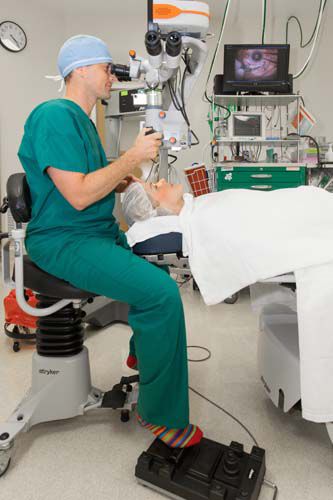
Floaters, in everyday parlance, are those hard-to-define shapes (often called specks, strings, amoeba-like illusions or cobwebs) that sometimes appear – seemingly out of nowhere – within our field of vision.
Medically speaking, these annoying floaters are complex, but the good news is there is now a safe and effective way to get rid of them.
Dr. Robert Reinauer at Vero Beach’s New Vision Eye Center explains.
“Floaters,” Reinauer says, “are mainly vitreous. You have a vitreous gel in the center of your eye and that’s what makes up the majority of your eye. A basketball is filled with air. The eye is filled with mainly vitreous gel.”
“That vitreous gel is a jello-type substance,” Reinauer continues, “that is 98 percent water and about 2 percent collagen. That’s collagen – like in our skin – and as time goes on, it wrinkles and shrinks and will pull away from the back of the eye. That’s what creates floaters.”
The National Eye Institute says that while the vast majority of people learn to ignore these visual anomalies, roughly 10 percent of the U.S. population suffers a more extreme form of visual impairment due to floaters.
According to the American Society of Retina Specialists, floaters can in some cases persistently interfere with a person’s vision. That can make simple tasks such as reading or even safely navigating a flight of stairs more difficult.
They can also make driving a car safely a nearly impossible task.
Floaters, it turns out, are something of an age-related numbers game and Reinauer uses percentages to make that point.
“Everybody,” says the likable Reinauer, “will get floaters or have a posterior vitreous separation as time goes on – 40 percent of patients over 40 years old have it; 50 percent over 50; 60 percent over 60 years old; and 70 percent over 70. By the time you’re 90, 90 percent of patients have vitreous gel come off the back of the eye.”
“Most eye floaters are caused by age-related changes inside the vitreous chamber of the eye,” reports the Mayo Clinic. “Microscopic fibers within the vitreous tend to clump together and cast tiny shadows on the retina which is what appears to us as floaters. They become more and more common with age.”
The best way to eliminate floaters, according to Reinauer, is a procedure known as a “vitrectomy.”
Even a cursory description of that procedure is probably not for the squeamish. An outpatient surgery with local anesthesia, a vitrectomy “sucks out” floaters and the vitreous debris that causes them. Meanwhile, nearly all the vitreous gel within the eye is also removed and replaced by a sterile saline solution which, Reinauer says, “your body re-filters over about 24-36 hours.”
But the results are both immediate and impressive.
“I would say 95 percent, if not more, of patients who have it done in one eye [immediately] want it done in the other eye,” says Reinauer.
“But what I really like,” he continues, “is that my patients are happy.”
And that happiness comes in many forms. One in particular clearly touched Reinauer.
“I had one gentleman who would volunteer for his church. He would drive the school bus for kids – go pick them up and take them on field trips,” but because of severe floaters, says the 38-year-old Reinauer, “he had to quit doing that. We did his vitrectomy surgery on both eyes and he said, ‘You know what? I finally feel safe enough that I can go back to doing those bus trips again.’”
Reinauer, who served his residency at Detroit’s famed Kresge Eye Institute, has now performed over 1,000 vitrectomy procedures here in Vero Beach.
The smile on Reinauer’s face does momentarily fade when the topic of another “floater-removal” procedure comes up. The ones that use lasers.
Laser vitreolysis, or laser removal of floaters, is not what it says it is, according to Reinauer. “You do not remove anything when you use a laser.” Instead, he explains, “You are breaking floaters up into small pieces. In other words,” he continues, “you’re taking a big problem and making it into multiple small problems and hoping that those multiple small problems are an improvement.”
Moreover, on a consumer-finance related note, Reinauer points out Medicare and most insurances will pay for vitrectomy procedures but not for laser-based “removals” of eye floaters.
And while no ophthalmology or optometry associations mention it, one of the side benefits to any vision improvement procedure must certainly be getting a clearer look at Reinauer’s super-snazzy, hyper-colorful socks, which are sort of mini-trademark of this particular highly skilled retinal surgeon.
Dr. Robert Reinauer is with New Vision Eye Center at 1055 37th Place in Vero. The phone is 772-257-8700.



